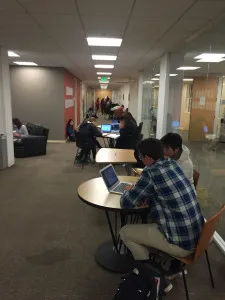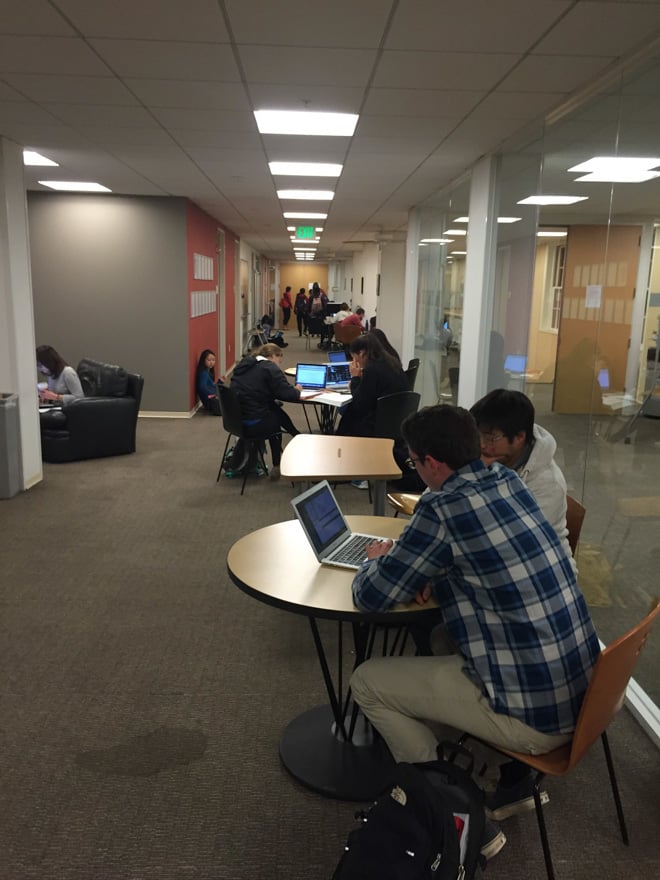
This quarter, LaIR hours, or office hours for the introductory CS 106 classes, were relocated from Tresidder to the second floor of Old Union. Students feel that the relocation to Old Union has compromised the efficiency of the LaIR.
At the LaIR, CS 106 students put their names into a queue and wait for help from section leaders, who are undergraduate and graduate students that teach smaller discussion sections for the CS 106 classes through the CS 198: “Teaching Computer Science” program. In addition to teaching and grading assignments for their designated groups of students, section leaders also hold weekly office hours in the LaIR. The LaIR is open Sundays through Thursdays from 6 p.m. until midnight.
Before it closed on June 11, the Tresidder LaIR computer cluster had rows of desks with computers. Each computer was labeled with a number so that students could let section leaders know where they were sitting. In contrast, the LaIR at Old Union is in an open common space with few computers.
Each quarter, the LaIR is organized by the current CS 198 coordinators, and last winter, director of learning environment integration Beth McCullough informed the coordinators of the relocation plans.
“We were told the LaIR could stay in Tresidder with a significantly reduced amount of square footage or it could move to the second floor of Old Union,” McCullough said in an email to The Daily. “Moving to Old Union seemed the better option given those two choices. I believe the motivation had to do with a need to create more office space.”
The decision to relocate the LaIR was made by the office of the vice provost for student affairs, which manages Tresidder and Old Union. According to Jeanette Smith-Laws, the director of operations and student unions for the vice provost for student affairs, the move was intended to create a more student-friendly environment for academic computing.
“Old Union is where students are. It is the place,” Smith-Laws said. “We wanted to have it feel like you could sit in other spaces and do that work and then interact with other people and not be so isolated.”
The new LaIR is located adjacent to the Tech Zone, which occupies Old Union Room 200 and contains computers and printers that are available to students. The Tech Zone is open 24 hours and is an asset to the new situation that, according to Smith-Laws, is an improvement from the resources in the old LaIR.
“[The Tresidder LaIR] hadn’t been upgraded in a long time,” Smith-Laws said. “The furniture, the equipment was in bad shape. It wasn’t the most inviting environment, and I think [Old Union] is a much better environment.”
The LaIR relocation to Old Union is a part of a greater initiative to create better spaces in Old Union for students.
“As part of that pilot, we are going to open Old Union up 24 hours, see how that works out and collect data from there,” Smith-Laws said.
Old Union currently operates from 8 a.m. to 2 a.m., and the Tech Zone is open 24/7.
Student response to the new location has been varied. Some students find Old Union to be a welcoming environment, praising the access to comfortable couches and food options.
“I personally like it at the Old Union because it is dangerously close to Axe and Palm and a plate full of chicken fingers,” said Matt Anderson ’19, a current student in CS 106A: “Programming Methodology.” “I always try to avoid getting them late at night but I seldom succeed in resisting.”
However, other students find the new location to be disorganized and inefficient, reporting longer wait times and confusion about the queue.
“The space is very long and narrow, with many different seating areas, so it is often the case that section leaders take a long time to find the student they are trying to help,” said Sinclair Cook ’18, a current CS 106B: “Programming Abstractions” student, in an email to The Daily. “I have been skipped multiple times because a section leader couldn’t find me.”
In contrast, the LaIR at Tresidder was a more contained space, which allowed section leaders to easily find students and move through the queue.
“I used the LaIR at Tresidder a few times last year,” Cook said. “I liked it because it was a dedicated space used solely for the purpose of CS 106. Also, because it was a single large, square room, it seemed like section leaders more efficiently found the students they were trying to help, which caused the queue to move faster.”
The current CS 198 coordinators, Nhien Tran BS ’15 MS ’16, Aaron Broder BS ’15 MS ’16 and Danielle Kain BS ’16 MS ’16 responded to complaints about inefficiency in an email to The Daily.
“We have not yet reviewed wait time data from this quarter, but wait times in the LaIR are typically longer in fall than in spring due to higher enrollments,” they wrote.
As of now, the LaIR will remain in Old Union for the foreseeable future. But if the data from this quarter shows unusually high wait times, another relocation may be possible, though no space is currently identified, McCullough explained.
“If a suitable, larger location were made available, we would be happy to explore that option,” McCullough said in an email to The Daily.
Contact Blanca Andrei at bandrei ‘at’ stanford.edu.
